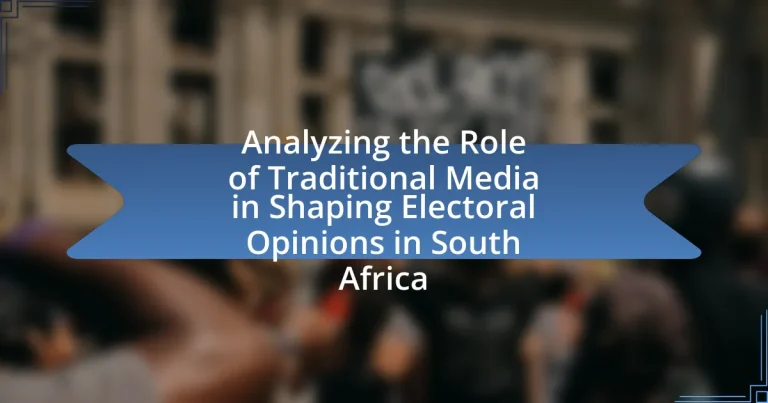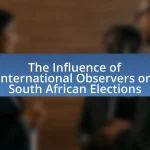The article analyzes the role of traditional media in shaping electoral opinions in South Africa, highlighting its significance in providing information, framing political narratives, and influencing public discourse. It discusses the impact of television and radio as primary sources of news, with a substantial portion of the population relying on these mediums for political information during elections. The article also examines how different demographics engage with traditional media, the relevance of these platforms in the digital age, and the challenges they face, including issues of bias and credibility. Additionally, it explores the historical context of traditional media in South African elections and offers insights into best practices for enhancing audience engagement and ensuring balanced coverage.
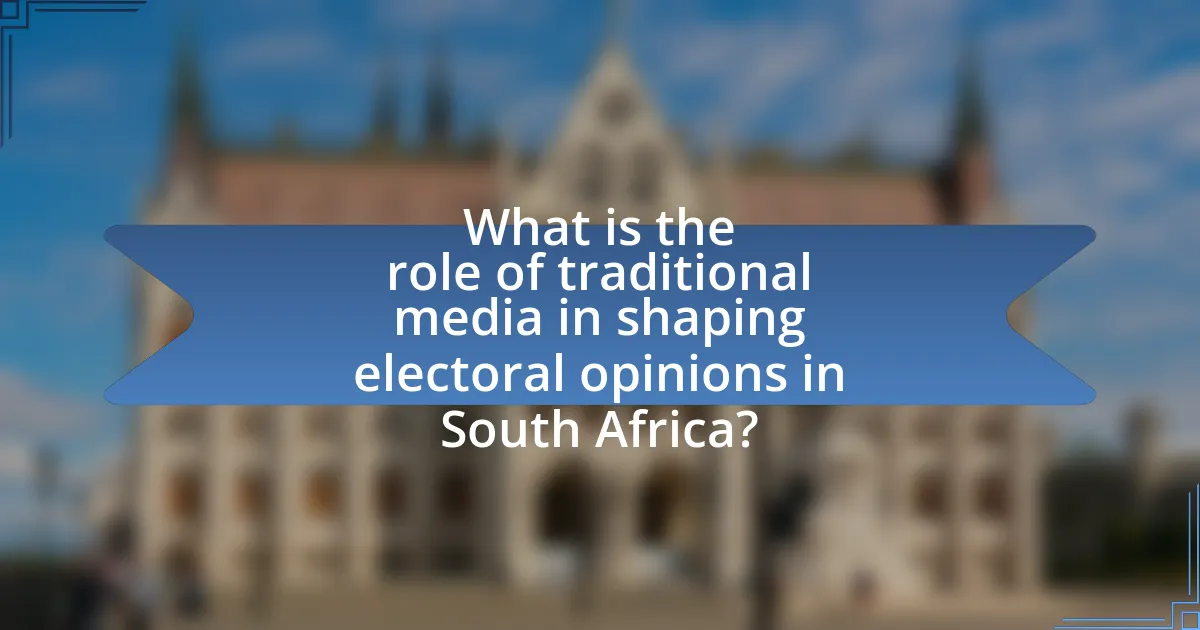
What is the role of traditional media in shaping electoral opinions in South Africa?
Traditional media plays a crucial role in shaping electoral opinions in South Africa by providing information, framing political narratives, and influencing public discourse. The South African Broadcasting Corporation (SABC) and various print media outlets serve as primary sources of news, impacting voter perceptions and decisions. Research indicates that traditional media coverage significantly affects voter behavior, with studies showing that 70% of South Africans rely on television and newspapers for political information during elections. This reliance underscores the media’s power in shaping electoral outcomes by highlighting specific issues, candidates, and party platforms, thereby guiding public opinion.
How does traditional media influence public perception during elections?
Traditional media significantly influences public perception during elections by shaping narratives and framing political discourse. For instance, television news coverage often highlights specific candidates or issues, which can lead to increased visibility and perceived importance among voters. Research indicates that media framing can affect voter attitudes; a study by the Media Monitoring Project in South Africa found that coverage favoring certain political parties correlated with higher voter support for those parties. Additionally, traditional media serves as a primary source of information for many voters, impacting their understanding of candidates’ policies and character, thereby directly influencing electoral outcomes.
What types of traditional media are most impactful in South Africa?
Television and radio are the most impactful types of traditional media in South Africa. Television reaches a wide audience, with over 30 million viewers, making it a key platform for political messaging and public discourse. Radio, with its extensive reach in rural areas, serves as a vital source of information, especially in communities with limited access to the internet. According to the South African Audience Research Foundation, radio remains the most consumed medium, with 90% of South Africans listening to it weekly. These media forms significantly influence electoral opinions by shaping public perceptions and providing critical information during elections.
How do different demographics engage with traditional media during elections?
Different demographics engage with traditional media during elections in varied ways, influenced by factors such as age, education, and socioeconomic status. For instance, older voters tend to rely more on television and radio for news, with studies indicating that 65% of individuals aged 50 and above prefer these mediums compared to younger voters who are more inclined to use digital platforms. In contrast, younger demographics, particularly those aged 18-34, often engage with traditional media less frequently, with only 30% reporting regular consumption of newspapers or television news. Additionally, education levels impact media engagement; individuals with higher education are more likely to seek out diverse news sources, including traditional media, while those with lower education levels may depend primarily on local radio and television for information. This variation in engagement highlights the importance of understanding demographic preferences to effectively communicate electoral messages through traditional media channels.
Why is traditional media still relevant in the digital age?
Traditional media remains relevant in the digital age because it provides trusted, credible information that is essential for informed decision-making. Research indicates that many audiences still rely on newspapers, television, and radio for news, particularly during elections, as these platforms are perceived to have higher journalistic standards compared to some digital sources. For instance, a study by the Pew Research Center found that 57% of adults in South Africa prefer traditional media for news, especially regarding political matters, highlighting its role in shaping electoral opinions.
What advantages does traditional media have over digital platforms in electoral contexts?
Traditional media offers several advantages over digital platforms in electoral contexts, particularly in South Africa. Firstly, traditional media, such as television and radio, has a broader reach among diverse demographics, including those with limited internet access. According to the South African Audience Research Foundation, as of 2022, over 80% of South Africans still rely on television as their primary news source, highlighting its significant influence.
Secondly, traditional media often provides more structured and regulated content, which can enhance credibility and trust among voters. For instance, established news organizations adhere to journalistic standards and ethics, which can mitigate the spread of misinformation that is prevalent on digital platforms.
Lastly, traditional media facilitates community engagement through local broadcasts and discussions, fostering a sense of connection and relevance to local electoral issues. This localized approach can effectively mobilize voters and shape public opinion in ways that digital platforms may not achieve as effectively.
How do traditional media outlets adapt to changing media consumption habits?
Traditional media outlets adapt to changing media consumption habits by integrating digital platforms and enhancing audience engagement through interactive content. For instance, many newspapers and television stations have developed mobile applications and websites that provide real-time news updates, catering to the increasing preference for on-demand information. According to a 2022 report by the South African Audience Research Foundation, 65% of South Africans now consume news primarily through digital channels, prompting traditional outlets to invest in social media strategies and multimedia storytelling to reach younger audiences. This shift not only helps maintain relevance but also allows traditional media to compete with emerging digital-only news sources.
What challenges does traditional media face in influencing electoral opinions?
Traditional media faces significant challenges in influencing electoral opinions, primarily due to the rise of digital platforms and changing audience behaviors. The proliferation of social media has shifted public attention away from traditional news sources, with a 2021 report indicating that 53% of South Africans prefer social media for news consumption over television or print. Additionally, traditional media often struggles with perceptions of bias and credibility, as audiences increasingly seek diverse viewpoints and may distrust established outlets. This distrust is compounded by the rapid dissemination of misinformation online, which can overshadow factual reporting from traditional media. Furthermore, economic pressures have led to reduced resources for investigative journalism, limiting the depth and quality of electoral coverage.
How do issues of bias and credibility affect traditional media’s role?
Issues of bias and credibility significantly undermine traditional media’s role by eroding public trust and influencing the perception of information. When traditional media outlets exhibit bias, they can skew the representation of facts, leading audiences to question the reliability of the news presented. For instance, a 2020 study by the Reuters Institute for the Study of Journalism found that 61% of South Africans believe that media bias affects their understanding of political issues. This skepticism can result in decreased engagement with traditional media, as audiences may turn to alternative sources perceived as more credible or impartial. Consequently, the effectiveness of traditional media in shaping electoral opinions diminishes, as voters may rely on less reliable information, ultimately impacting democratic processes.
What are the implications of media ownership on electoral coverage?
Media ownership significantly influences electoral coverage by determining which narratives are prioritized and how candidates are portrayed. In South Africa, concentrated media ownership often leads to biased reporting, favoring certain political parties or interests aligned with the owners. For instance, research by the Media Monitoring Africa organization highlights that media outlets owned by individuals or corporations with political ties tend to exhibit partiality, impacting public perception and voter behavior. This ownership structure can limit diverse viewpoints, thereby shaping electoral outcomes and undermining democratic processes.
How does traditional media interact with social media in shaping electoral opinions?
Traditional media interacts with social media by amplifying messages and framing narratives that influence electoral opinions. For instance, news outlets often report on political events and issues, which are then shared and discussed on social media platforms, creating a feedback loop that can shape public perception. Research indicates that traditional media coverage can set the agenda for social media discussions, as seen in the 2019 South African elections, where major news stories were widely circulated on platforms like Twitter and Facebook, affecting voter sentiment and engagement. This interaction highlights the symbiotic relationship between the two media forms, where traditional media provides content that social media users disseminate, thereby impacting electoral opinions.
What specific strategies can traditional media employ to enhance their influence?
Traditional media can enhance their influence by adopting multi-platform strategies, engaging in community-focused reporting, and leveraging data analytics for audience insights. Multi-platform strategies involve distributing content across various channels, such as television, radio, print, and digital platforms, to reach a broader audience. For instance, the South African Broadcasting Corporation (SABC) has utilized both traditional and digital media to engage diverse demographics effectively. Community-focused reporting fosters trust and relevance by addressing local issues and involving community voices, which can increase audience loyalty and engagement. Furthermore, leveraging data analytics allows traditional media to understand audience preferences and tailor content accordingly, as evidenced by the success of media outlets that analyze viewer metrics to optimize programming. These strategies collectively contribute to a more significant impact on public opinion and electoral discourse.
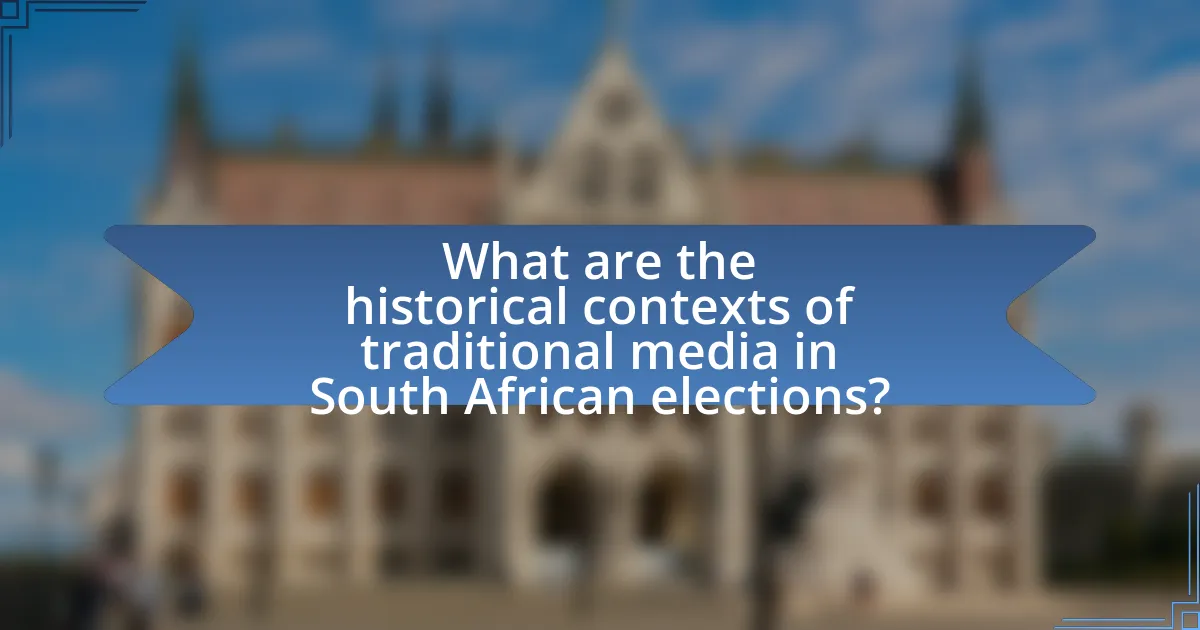
What are the historical contexts of traditional media in South African elections?
Traditional media in South African elections has evolved significantly since the country’s transition to democracy in 1994. Initially, traditional media, including newspapers, radio, and television, played a crucial role in informing the public about political developments and facilitating discourse during the apartheid era, where censorship limited access to information. The establishment of a free press post-1994 allowed for diverse political viewpoints to be expressed, contributing to a more informed electorate. For instance, the South African Broadcasting Corporation (SABC) became a key player in providing coverage of elections, while newspapers like the Mail & Guardian and The Star emerged as platforms for investigative journalism and political commentary. This historical context highlights the transition from state-controlled narratives to a more pluralistic media landscape, which has shaped electoral opinions and influenced voter behavior in South Africa.
How has the role of traditional media evolved over the decades?
The role of traditional media has evolved from being the primary source of information to a more fragmented and competitive landscape influenced by digital media. In the mid-20th century, traditional media, including newspapers, radio, and television, dominated public discourse and shaped electoral opinions through extensive coverage and analysis of political events. For instance, during the 1994 South African elections, television and print media played crucial roles in informing the public about the democratic transition and the significance of voting.
However, with the advent of the internet and social media in the late 1990s and early 2000s, traditional media’s influence began to decline as audiences shifted towards online platforms for news consumption. By the 2010s, traditional media faced challenges such as declining readership and advertising revenue, leading to a need for adaptation. Many traditional outlets started to establish online presences and engage with audiences through social media, aiming to maintain relevance in a rapidly changing media environment.
This evolution reflects a broader trend where traditional media now competes with digital platforms for audience attention, requiring a shift in strategies to engage and inform the electorate effectively.
What significant events have shaped the relationship between media and elections in South Africa?
Significant events that have shaped the relationship between media and elections in South Africa include the transition to democracy in 1994, the establishment of the Independent Communications Authority of South Africa (ICASA) in 2000, and the rise of digital media in the 2010s. The 1994 elections marked a pivotal moment, as the media played a crucial role in informing the public about the new democratic processes and political parties. ICASA was created to regulate broadcasting and ensure fair media representation, impacting how elections were covered. Additionally, the emergence of social media platforms has transformed electoral campaigning and voter engagement, influencing public opinion and political discourse. These events collectively illustrate the evolving dynamics between media and electoral processes in South Africa.
How did apartheid influence media practices and electoral opinions?
Apartheid significantly influenced media practices and electoral opinions in South Africa by enforcing strict censorship and promoting propaganda that favored the ruling National Party. During apartheid, the government controlled media outlets, limiting coverage of anti-apartheid movements and dissenting voices, which shaped public perception and electoral behavior. For instance, the 1980s saw the introduction of the Publications Act, which restricted the publication of materials deemed subversive, thereby skewing the information available to the electorate. This manipulation of media not only suppressed opposition viewpoints but also created a narrative that justified the apartheid regime, ultimately affecting how citizens viewed elections and their participation in the democratic process.
What lessons can be learned from past electoral media coverage?
Past electoral media coverage reveals the importance of balanced reporting, as biased coverage can skew public perception and influence election outcomes. For instance, during the 1994 South African elections, media bias towards the African National Congress led to significant shifts in voter sentiment, demonstrating how media framing can affect electoral results. Additionally, the coverage of political debates and candidate performances has shown that in-depth analysis and fact-checking are crucial for informing voters, as seen in the 2019 elections where misinformation spread rapidly through social media, highlighting the need for traditional media to uphold journalistic standards. These lessons emphasize the necessity for media outlets to provide fair, accurate, and comprehensive coverage to foster informed electoral decisions.
How have past media strategies impacted current electoral outcomes?
Past media strategies have significantly influenced current electoral outcomes by shaping public perceptions and voter behavior. For instance, during the 1994 South African elections, the extensive use of television and radio campaigns helped to mobilize voters and inform them about the democratic process, resulting in a historic voter turnout of 86%. This high engagement was largely due to the media’s role in disseminating information about candidates and policies, which established a precedent for future elections. Additionally, the framing of issues in media coverage has continued to affect voter priorities, as seen in the 2019 elections where social media campaigns targeted specific demographics, influencing their voting decisions. Thus, the legacy of past media strategies continues to resonate in contemporary electoral dynamics, demonstrating their lasting impact on voter engagement and electoral outcomes.
What role did traditional media play in key historical elections?
Traditional media played a crucial role in key historical elections by shaping public opinion, disseminating information, and influencing voter behavior. For instance, during the 1994 South African elections, traditional media outlets such as newspapers, radio, and television were instrumental in informing the electorate about the new democratic processes and the significance of voting. The media provided extensive coverage of political parties, candidates, and their policies, which helped voters make informed decisions. Additionally, the South African Broadcasting Corporation (SABC) served as a primary source of information, reaching millions and facilitating discussions around the elections. This extensive media engagement contributed to a record voter turnout of over 86%, highlighting the impact of traditional media in mobilizing the electorate and fostering democratic participation.
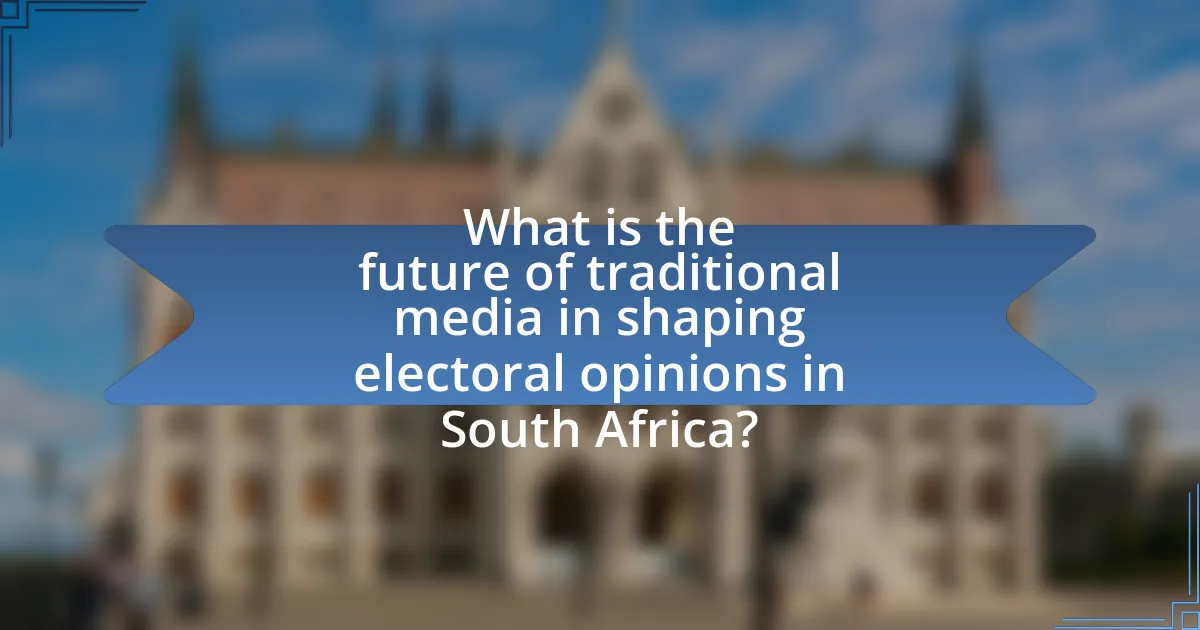
What is the future of traditional media in shaping electoral opinions in South Africa?
The future of traditional media in shaping electoral opinions in South Africa is likely to diminish as digital platforms gain prominence. Traditional media, including newspapers and television, historically influenced public opinion and voter behavior, but recent trends indicate a shift towards online news consumption. According to the South African Audience Research Foundation, as of 2022, over 60% of South Africans access news primarily through digital channels, reflecting a significant change in media consumption habits. This shift suggests that while traditional media will still play a role, its impact on electoral opinions will increasingly be overshadowed by the immediacy and accessibility of digital media.
How might emerging technologies affect traditional media’s role in elections?
Emerging technologies significantly alter traditional media’s role in elections by enhancing information dissemination and audience engagement. For instance, social media platforms enable real-time communication and allow candidates to reach voters directly, often bypassing traditional media channels. This shift can diminish traditional media’s gatekeeping function, as voters increasingly rely on digital platforms for news and updates. According to a 2020 study by the Pew Research Center, 53% of U.S. adults reported getting news from social media, illustrating a trend that is likely mirrored in South Africa. Consequently, traditional media must adapt by integrating digital strategies to maintain relevance and influence in shaping electoral opinions.
What trends are emerging in the consumption of traditional media during elections?
Emerging trends in the consumption of traditional media during elections include a significant increase in the viewership of television news and a decline in print media readership. Research indicates that during the 2021 South African local elections, television remained the primary source of political information for 62% of voters, while print media usage dropped to 15%. Additionally, there is a growing reliance on radio broadcasts, particularly among rural populations, with 40% of voters citing it as their main source of election-related news. These trends reflect a shift towards visual and auditory media formats, driven by accessibility and immediacy, as voters seek timely updates and analysis during election periods.
How can traditional media leverage technology to remain influential?
Traditional media can leverage technology by integrating digital platforms to enhance content distribution and audience engagement. By utilizing social media, traditional media outlets can reach broader demographics, particularly younger audiences who predominantly consume news online. For instance, a study by the Pew Research Center in 2021 indicated that 53% of adults aged 18-29 get their news from social media, highlighting the necessity for traditional media to adapt. Additionally, employing data analytics allows traditional media to tailor content to audience preferences, thereby increasing relevance and influence. This strategic use of technology not only maintains traditional media’s relevance but also reinforces its role in shaping electoral opinions in South Africa.
What best practices should traditional media adopt for future elections?
Traditional media should adopt fact-checking, unbiased reporting, and enhanced engagement with audiences as best practices for future elections. Fact-checking ensures that information disseminated is accurate, which is crucial in combating misinformation that can influence voter perceptions. Unbiased reporting fosters trust among the electorate, as seen in studies indicating that impartial coverage leads to higher public confidence in media sources. Enhanced audience engagement, through interactive platforms and social media integration, allows traditional media to reach younger demographics and encourage informed discussions, reflecting the changing media consumption habits in South Africa. These practices collectively contribute to a more informed electorate and a healthier democratic process.
How can traditional media ensure balanced and fair coverage?
Traditional media can ensure balanced and fair coverage by adhering to journalistic standards that prioritize objectivity, accuracy, and impartiality. This involves presenting multiple viewpoints on issues, particularly during elections, to reflect the diversity of opinions within the electorate. For instance, the South African Press Code mandates that media outlets provide fair representation of all parties and candidates, ensuring that no single perspective dominates the narrative. Additionally, employing fact-checking processes and sourcing information from credible experts can enhance the reliability of the coverage, thereby fostering trust among the audience.
What strategies can enhance audience engagement and trust in traditional media?
To enhance audience engagement and trust in traditional media, media organizations should prioritize transparency, community involvement, and quality content. Transparency can be achieved by openly sharing editorial processes and correcting errors promptly, which builds credibility; for instance, a study by the Pew Research Center found that 62% of Americans believe that transparency in reporting increases trust in news organizations. Community involvement can be fostered through local news coverage and audience feedback mechanisms, which create a sense of belonging and relevance; research indicates that local news outlets that engage with their communities see higher audience loyalty. Lastly, producing high-quality, fact-checked content that prioritizes accuracy over sensationalism is essential, as audiences are more likely to trust media that consistently delivers reliable information.
What practical tips can traditional media follow to effectively shape electoral opinions?
Traditional media can effectively shape electoral opinions by prioritizing accurate reporting, engaging in fact-checking, and providing diverse viewpoints. Accurate reporting ensures that the electorate receives reliable information, which is crucial for informed decision-making. Engaging in fact-checking helps to combat misinformation, as studies show that voters are more likely to trust media that corrects false claims. Providing diverse viewpoints fosters a balanced discourse, allowing audiences to consider multiple perspectives, which is essential in a democratic society like South Africa, where varied opinions exist.
